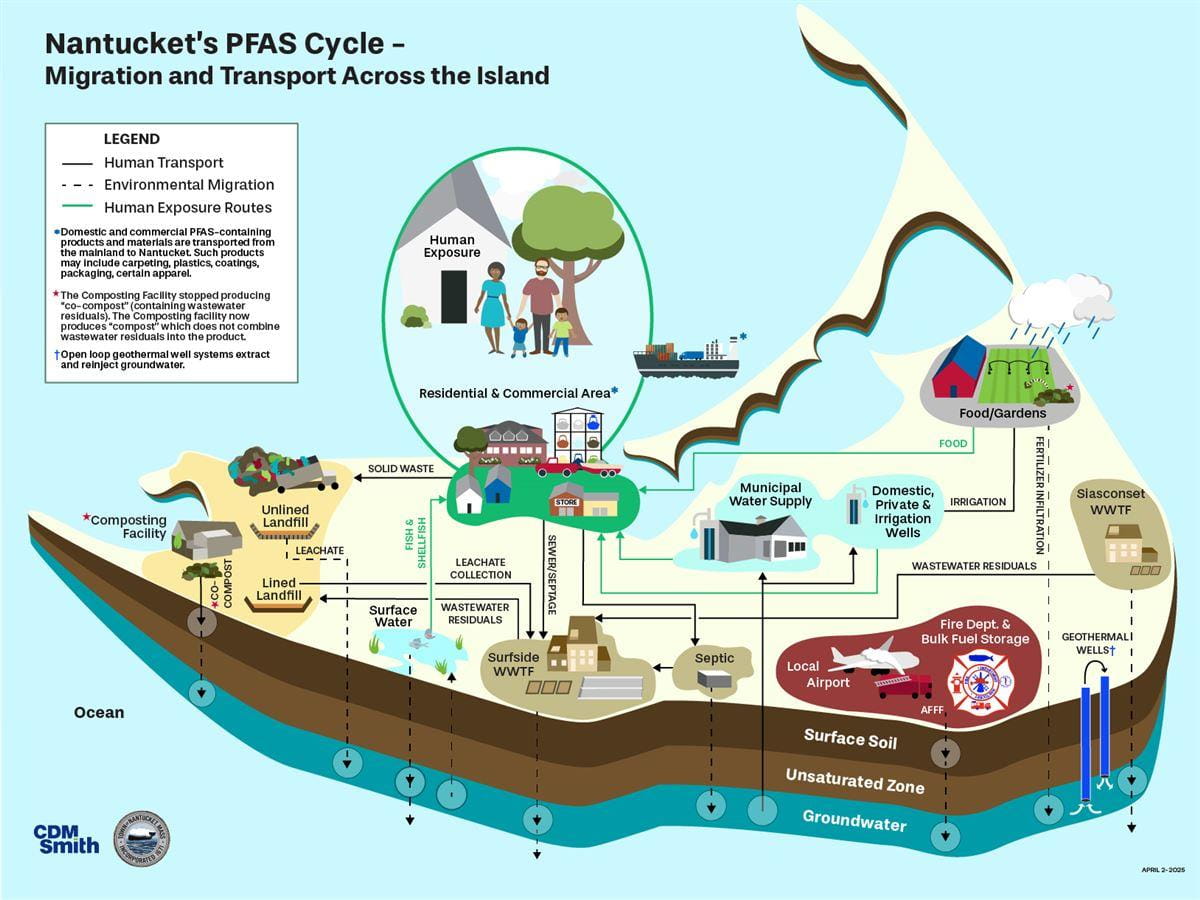Nantucket Charts Course to Break the Cycle of PFAS
On October 2, 2020, the Massachusetts Department of Environmental Protection promulgated drinking water standards for “PFAS-6,” shorthand for six potentially toxic analytes: PFOS, PFOA, PFHxS, PFNA, PFHpA and PFDA. On the island of Nantucket, community leaders wasted no time in responding. And Nantucket’s situation was unique for a community facing PFAS. Named “the Faraway Land” by the Wampanoag tribe, the island’s original inhabitants, Nantucket is a self-sustaining community with many unique environmental challenges. Residents, visitors and businesses are solely dependent on the infrastructure and resources existing within 48 square miles.
The town’s primary concern is protecting public health and the preservation of the island’s sole source aquifer, which provides drinking water to everyone on the island. Soon after sampling efforts confirmed their suspicions of PFAS contamination, the town contracted CDM Smith in July 2020 to develop a unified and proactive PFAS management plan that would help protect the island’s precious groundwater resources.
Certain firefighting foams had already been identified as potent PFAS spreaders, and the island’s airport—a critical piece of local infrastructure—had been required to use those foams as part of federal regulatory requirements. The island also has a very active biosolids and composting program, associated with the wastewater treatment facility and landfill, which are receivers of residential and commercial PFAS sources on the island.
To design a treatment and mitigation strategy, CDM Smith helped the town first understand where its PFAS was coming from and how it moved through the local ecosystem.

“This is the first proof of concept of our unique PFAS cycle approach,” said Rose Hanson. CDM Smith strategic communications expert. “Our bigger goal is to help the town break this cycle and prevent the transport of PFAS from one source to another."
What started as a preliminary investigation turned into a multi-year public outreach campaign, an action plan to address the presence of PFAS contamination from multiple sources—commercial and household use, wastewater treatment residuals, or biosolids, and aqueous film forming foams, or AFFFs—and ongoing strategies to track and understand how to handle the contaminants as they move through the island’s PFAS cycle.
Our goal is to help the town break the PFAS cycle and prevent the transport of PFAS from one source to another.
The project team embarked on a multi-disciplinary effort that included engineers, scientists, planners, and communications specialists who performed outreach to all town departments—water, sewer, airport, public works, solid waste, health, natural resources, fire, public outreach/communications, finance, and the town manager’s office. Other stakeholders included the Nantucket select board, board of health, community groups and residents, as well as state agencies.
CDM Smith PFAS experts developed recommendations on how best to break the PFAS cycle through future implementation of appropriate mitigation and control measures, with the intent of creating a town-wide PFAS source control and reduction plan. Development of a PFAS cycle unique to Nantucket was a critical early step in CDM Smith’s assessment process. Visualizing the island’s unique cycle of contamination allowed the town to visualize how it could take action and achieve PFAS source reduction and control.
Public education and outreach are critical to the success of a PFAS management plan implementation. This piece of the project included facilitation of a town-wide PFAS communication team and charter, preparation of a public outreach strategy and plan, development of communication materials (i.e., fact sheets, FAQs, town website updates, press releases), and presentations at town community meetings.
CDM Smith developed a wastewater and biosolids decision matrix to guide the town through investigation and mitigation of PFAS in the town’s wastewater. The matrix outlines a step-by-step approach to PFAS source identification through a comprehensive data collection and sampling plan. The matrix also identifies potential mitigation measures to help identify and reduce or eliminate PFAS point sources to the wastewater treatment plants.
The town-wide PFAS assessment project ultimately identified several potential sources of PFAS relative to solid waste operations at the landfill. The Preliminary Assessment of PFAS Town-Wide Planning Approach presented recommendations for further evaluation of these potential sources.
CDM Smith continues to support the town of Nantucket with the implementation of recommendations during the follow-on Phase 2A Townwide PFAS assessment effort. This effort has been focused on establishing steps for sampling and evaluation to recommend PFAS reduction and mitigation strategies.
For more information on breaking the PFAS cycle and to read more stories like this one, subscribe to the Breaking Down PFAS newsletter.

Inventory and replacement scenarios have multiple opportunities to demonstrate transparency and accountability, building relationships through communication.








